Welcome to the NFL 100, The Athletic’s endeavor to identify the 100 best players in football history. You can order the book version here. Every day until the season begins, we’ll unveil new members of the list, with the No. 1 player to be crowned on Wednesday, Sept. 8.
How do you determine the best of the best?
Advertisement
That’s a question we’ve debated here at The Athletic as we endeavored to build the NFL 100. It’s our attempt to crown the 100 best players in the history of the NFL, from its inception in 1920 until now. (You can order the book version here.)
We were inspired by our friend Joe Posnanski’s efforts last year to author a similar project, the Baseball 100. Posnanski said of his massive project: “This is a nutty thing to do.”
Well, this was a nutty thing to do in the football world, too. There’s a reason they don’t rank the players at the Pro Football Hall of Fame in Canton, Ohio, right? It’s too hard. Once you earn that gold jacket, you’re part of the club. There’s no pecking order. Also, football has changed drastically since 1920. Comparisons between players of different eras are not really fair. And unlike baseball, we can’t easily compare players across positions. The job requirements of a center fielder in the 1940s for Joe DiMaggio are largely the same today when Mike Trout is playing the position. The job requirements of a defensive back in the 1940s? Well, for one thing, he probably played both offense and defense, but the position bears little resemblance now to the roles that Jalen Ramsey and Tyrann Mathieu play.
So it was excruciating at times as we looked to separate the greatest players who have ever stepped on the gridiron. We were searching for blemishes on résumés that, frankly, don’t have any.
Still, we got there. Your NFL 100 will surely be different from ours. Your rankings of how the players should line up will also undoubtedly be different than ours. That’s OK. It’s part of what makes these projects enjoyable.
We compiled the NFL 100 with a panel of football journalists from The Athletic — former NFL managing editor Lisa Wilson and Pro Hall of Fame voters Ed Bouchette, Jeff Duncan, Dan Pompei and Mike Sando. These rankings reflect their collective decisions.
No. 100: Derrick Brooks

Brooks was a core leader for the Tampa Bay Buccaneers and a central part of their Super Bowl championship in the 2002 season. Listed at 6 feet and 235 pounds, he came into the league with questions about his size but ushered in an era of smaller, quicker linebackers who had speed and range to match their tackling ability. MORE
Advertisement
No. 99: Dermontti Dawson

When you saw Dawson — the longtime Pittsburgh Steelers center who was a six-time All-Pro and a Hall of Famer — the first words out of everybody’s mouths is how he pulled as a center. Nowadays that doesn’t seem like a big deal. Thirty years ago, it was almost unheard of. MORE
No. 98: Steve Van Buren

In his later years, Van Buren —a Philadelphia Eagles running back from 1944-51 who retired as the NFL’s career rushing leader — lived in a spartan apartment in Northeast Philadelphia with his cat. There were no vestiges of his greatness, no trophies or memorabilia. He kept photos of his grandchildren, but you wouldn’t know he scored the game-winning touchdown in the 1948 championship game, a play that was ranked the 91st greatest in league history. MORE
No. 97: Jim Otto

The story of the Raiders can’t be told without Jim Otto. From his center position, the undersized Otto pushed and led the franchise by example, leaving a trail of sweat and tears. And a lot of blood. “I couldn’t believe how much of a beating he took,” linebacker Phil Villapiano said. “Jim Otto just out-toughed everybody.” MORE
No. 96: Mike Ditka

He’s known by many for his coaching success, but Ditka the tight end found every aspect of playing football exhilarating — the anticipation and angst, the conflict and collisions, the speed and strategy, the pain and precision, the jolts and jubilation. He once said he played every game like it was his last, a statement no one who ever saw him put his hand in the dirt would take issue with. MORE
No. 95: Fran Tarkenton

Tarkenton was two decades ahead of Randall Cunningham and Steve Young, four ahead of Michael Vick, five ahead of Russell Wilson and Lamar Jackson. He was a trailblazer, a rebel whose gumption made plenty of enemies in his own era but left a path for those who followed. He changed the game. He showed that quarterbacks can do more. MORE
Advertisement
No. 94: Elroy Hirsch
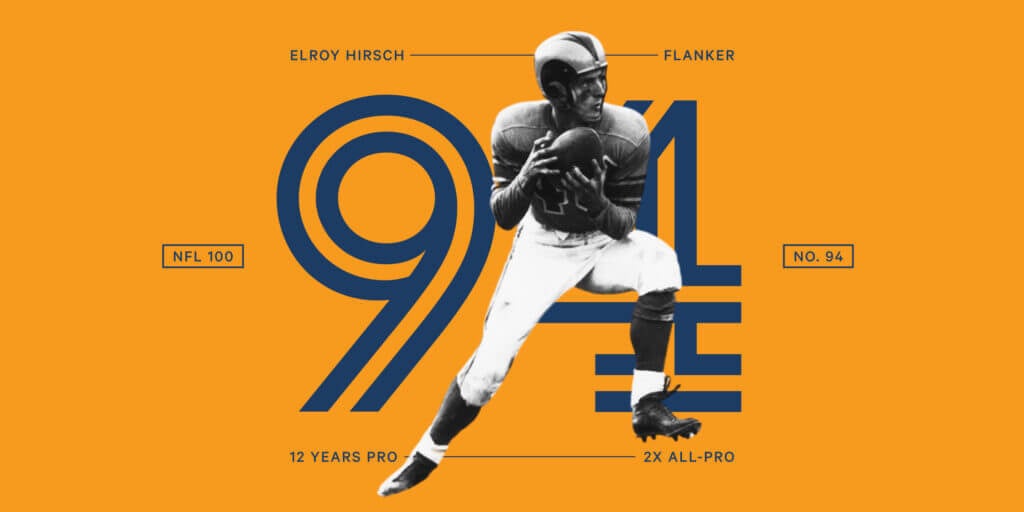
He was known as “Crazylegs” and was a man before his time who put up monstrous receiving numbers at a time when the NFL was just beginning to transition from 3-yards-and-a-cloud-of-dust to a more wide-open game that featured the forward pass. He was Tyreek Hill before Tyreek Hill. MORE
No. 93: Mike Singletary

Much of what made Singletary special to the Bears was intangible. He didn’t make his living with athleticism and speed as did his Hall of Fame successor Brian Urlacher. He made plays with desire, leverage, technique, precision and knowledge that could only come from thorough preparation. MORE
No. 92: Lenny Moore

Moore was the NFL’s quintessential, dual-threat running back before anyone used that term. The former Baltimore Colts star was the prototype for the likes of Marcus Allen, Roger Craig, LaDainian Tomlinson, Marshall Faulk, Christian McCaffrey and every other versatile back who followed him. MORE
No. 91: Willie Davis

Davis was the winning side of what has been dubbed by many as one of the most lopsided trades in NFL history. When he arrived in Green Bay, Vince Lombardi made him a defensive end and infused him with confidence. That catapulted him into a relentless defender for the next decade. MORE
No. 90: Willie Brown

Brown is most known for his 75-yard pick-six to help seal the Raiders’ win in Super Bowl XI, but his game went beyond the flash plays. He’s not considered by many to be the best corner ever but he was undoubtedly one of the best corners in pro football history. MORE
No. 89: Bobby Layne
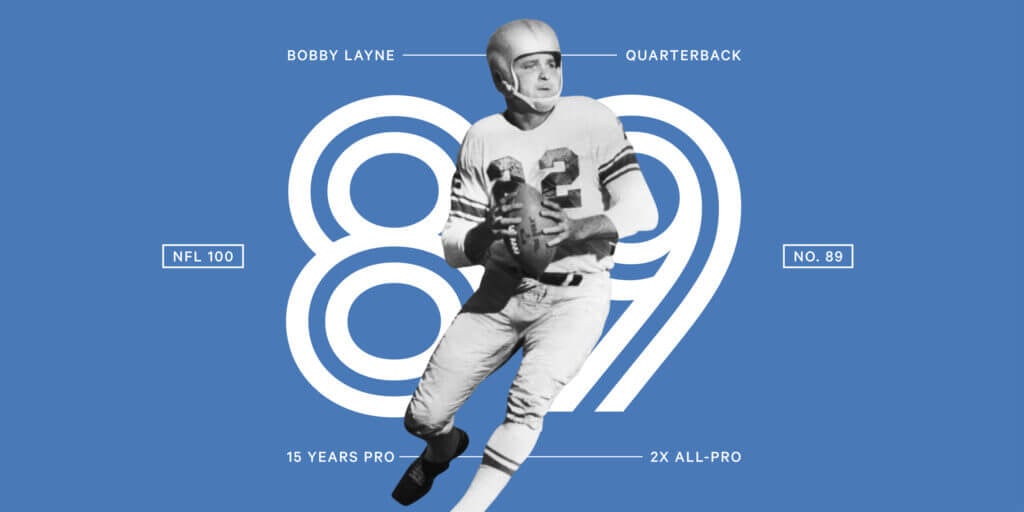
At least part of Layne’s fabled tale as a Lion lives in objective reality. He truly was brought to Detroit to save the franchise. He was also soaked in swagger. If Layne was turnover-prone in a game, it was always the offensive line’s fault. If Layne pulled a game out of the fire, his narrative was often that he’d done so in spite of everyone else around him. Layne never — ever — actually lost a football game. MORE
No. 88: Darrell Green

Green played 20 seasons for Washington, but only after quickly learning that the traditional approach to playing cornerback was not going to work for him. What he had to rely upon, then, was his blazing speed. And he ran with that speed all the way to the Hall of Fame. MORE
No. 87: Champ Bailey

For 15 years, Bailey combined his natural athleticism with uncanny field vision and an impeccable work ethic to become one of the NFL’s best all-around cornerbacks. “It’s the same thing I hear when I listen to guys talk about what it was like playing with Peyton Manning,” said former Broncos safety Nick Ferguson. “It was just a belief that you were in every single game. With Champ, it was the same thing.” MORE
Advertisement
No. 86: Buck Buchanan

In today’s game, players possessing rare physical characteristics are perfectly quantified and calculated. Those didn’t exist when Buchanan entered was the AFL’s No. 1 draft pick in 1963. You quantified athletic freakiness by the words of those tasked with stopping him. MORE
No. 85: Bulldog Turner

Centers rarely make the headlines. They clear holes for running backs and protect their quarterbacks. But centers who also intercept passes as a linebacker get noticed. This is where Clyde “Bulldog” Turner, fits in. MORE
No. 84: Mel Hein

If Hein’s name doesn’t ring a bell, don’t fret. After all, the Pro Football Hall of Famer won the NFL’s first Most Valuable Player award a long, long time ago. As a member of the Hall’s inaugural Class of 1963, Hein’s been a part of football lore for decades. MORE
No. 83: Leo Nomellini

The greatest defensive lineman in 49ers history never played organized sports in high school and was a U.S. Marine combat veteran before taking his first snap of college football. When his NFL career finished after 14 seasons, he had earned more money on the professional wrestling circuit than he ever earned pinning down Johnny Unitas, Frank Gifford or Jim Brown. Yet, said Bud Grant, “I put him there with Walter Payton and Chuck Bednarik among the players I have seen or gone against.” MORE
No. 82: Kellen Winslow

Winslow was ahead of his time. He showcased what a tight end could be in the passing game. He laid the groundwork for what the tight end has become in the modern NFL: first and foremost, a mismatch weapon for the offense. MORE
No. 81: John Mackey

Mackey was a transcendent player for the Baltimore Colts: the wide frame that was such an inviting target for quarterbacks, the anticipation skills and awareness, and the breakaway speed that never before had been so evident from a tight end that size. Plus, he changed the game after he was done playing. MORE
No. 80: Willie Lanier

Lanier describes his rise into one of the best NFL linebackers in league history as “somewhat unique.” The Hall of Fame defender simply saw football as a skill he excelled at, which led to all-time great accolades he never craved. MORE
No. 79: Mike Haynes

Haynes wasn’t even planning on playing college football. Then fate worked in his favor and he ended up in the Hall of Fame after seven years with the Patriots and seven more excelling as a cornerback for the Raiders. MORE
No. 78: Roger Staubach

Staubach won two Super Bowls in Dallas and helped the Cowboys to become “America’s Team.” He had the ability to scramble and create something out of nothing at an elite level — long before it was common among top quarterbacks. MORE
No. 77: Ted Hendricks

Hendricks studied his opponents, but he also studied literature, math and physics. His brainpower was part of what made him great. The linebacker won 4 Super Bowls — one with the Colts and three with the Raiders. Washington coach George Allen called Hendricks “the most opportunistic player” he ever saw. MORE
Advertisement
No. 76: Art Shell

The Raiders tackle made the Pro Bowl eight times, was named first-team All-Pro twice, second-team All-Pro two other times and was a two-time Super Bowl champion. Even if the 18-year coaching career that followed never happened, he would’ve been honored as a football legend. MORE
No. 75: Paul Warfield

Though his receiving numbers might look paltry in today’s pass-happy NFL, Warfield’s 20.1 yards-per-catch average ranks among the best in league history. “He was as good as anybody that’s ever come into the NFL,” Gil Brandt said. MORE
No. 74: Bobby Bell

Bell was so talented that longtime Chiefs coach Hank Stram once said, “We had difficulty trying to figure out where to play him.” The Hall of Fame linebacker won three titles with the Chiefs. MORE
No. 73: Marion Motley

Motley was a trailblazer. He was also a punishing runner, an adept blocker and player gifted and instinctive enough to excel on both sides of the ball. Coach Paul Brown once wrote that he believed Motley could have been a Hall of Fame-caliber player only as a linebacker had the Browns not used him on offense. MORE
No. 72: Adrian Peterson

Peterson has made a career out of making even the most prepared defenses look silly. If geometry scholars studied his work rushing for 14,820 yards, they would be confounded by his ability to erase the right angles like some kind anti-Pythagorean Theorem. MORE
No. 71: Mel Blount

After eight seasons, four Super Bowls, three All-Pro nods, one Defensive Player of the Year award and 35 interceptions, the NFL decided to stop Mel Blount. They tried to stop Mel Blount. Easier said than done for a 6-foot-3, 205-pound, ball-seeking missile. He adapted on the fly and remained one of the best cover corners in the league. MORE
No. 70: Marshall Faulk

During his 12-year NFL career with the Colts and St. Louis Rams, Faulk redefined the running back position and became the archetype for modern-day backs. With his cat-quick elusiveness and sprinter’s speed, Faulk routinely made defenders look silly in the open field. Yet, he also had the power and toughness to run between the tackles. MORE
Advertisement
No. 69: Terry Bradshaw

Bradshaw, the Blond Bomber, threw 212 touchdown passes and had a 107-51 record in the regular season and 14-5 in the postseason, including a 4-0 mark in Super Bowls. He earned the league’s MVP award in 1978 and two Super Bowl MVPs. It took Bradshaw three years to become a winner, and then he never stopped. MORE
No. 68: Charles Woodson

Woodson spent 18 years between the Raiders and Packers as a Hall of Fame cornerback and safety, even making the Pro Bowl —for a ninth time — in his final season at age 39. “I always considered myself like seasoning salt,” Woodson said. “You can put seasoning salt on anything and it’s going to make it better.” MORE
No. 67: Gene Upshaw

Upshaw was a vocal leader of both the Raiders — “He never stopped talking, you would hear him before you could see him,” Art Shell said — and the NFL Players Association, where he served as the executive director until his death. “If you look at the history of the NFL, you’re going to find out that he was one of the most influential people that the league has known,” John Madden once said. MORE
No. 66: Earl Campbell
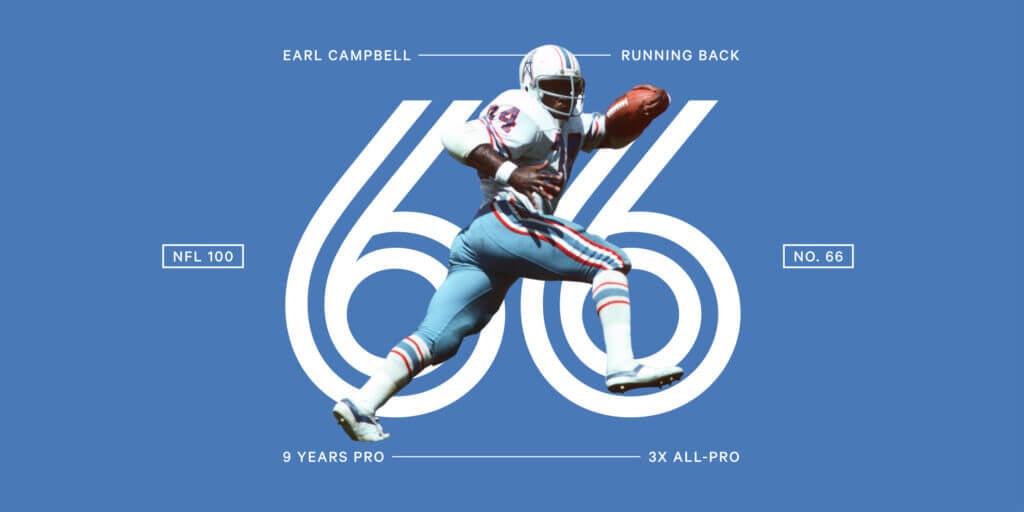
Campbell didn’t look like other running backs. He was bowlegged. His shoulders seemed to stretch from hash to hash. Each thigh was like the trunk of a mature oak tree. “In my time, I never saw anyone who possessed the power and speed he had,” Steelers great Joe Greene said. “There probably never was one.” MORE
No. 65: Joe Schmidt

Schmidt — the first true “quarterback of the defense” — began his career in Detroit with zero notoriety. But by the close of Schmidt’s first exhibition season in 1953, Lions coach Buddy Parker had traded star defender Don Doll for draft picks and all but declared Schmidt the future of the defense. MORE
No. 64: Walter Jones

Jones became a Seahawks icon and one of the game’s all-time great left tackles. In 1999 he became the franchise’s first offensive lineman to make the Pro Bowl and led Seattle to its first Super Bowl appearance in the 2005 season while proving to be one of the game’s best blockers. He allowed just 23 sacks in 180 regular-season starts. MORE
No. 63: Raymond Berry

Berry was the NFL’s best receiver with the Baltimore Colts en route to two championships in the 1950s. And that’s the team he still wants to be associated with: “I’m still a Baltimore Colt, and I always will be. I don’t really have any identification with the Indianapolis Colts or the Baltimore Ravens. Neither one of them are my team. I’m a Baltimore Colt until I die.” MORE
Advertisement
No. 62: Ray Nitschke

Nitschke, long after his career as the menacing Packers linebacker who won five titles, spent two decades informing new Pro Football Hall of Famers none was bigger than the rest. He was Canton’s conscience. “He was a natural-born leader,” Hall of Fame right tackle Ron Yary said. MORE
No. 61: Bart Starr

The Packers great — who led the team to five NFL titles in the 1960s — set a standard for leadership, excellence and class on and off the field. He was Tom Brady four decades before Tom Brady. MORE
No. 60: Jonathan Ogden

With the massive tackle for the Ravens, it wasn’t just about his size, though that’s where it started. He was so big and powerful that he could absorb a bullrush without giving up ground and consistently knock defenders back in the run game. He was so quick and athletic that he had little trouble getting out of his stance and negating a speed rush or getting to the second level. MORE
No. 59: Junior Seau
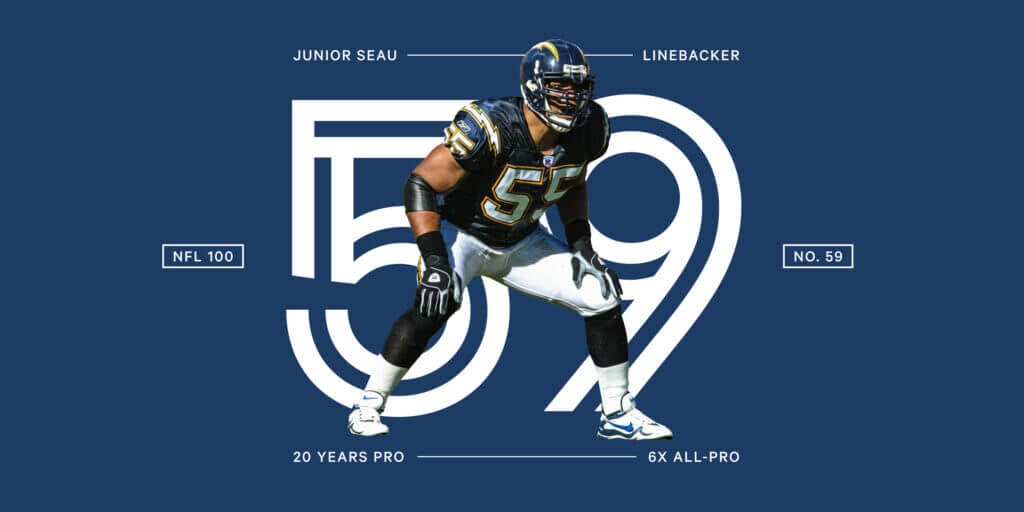
Seau dominated at linebacker for 20 years, but the impact he had on the Chargers, Patriots and Dolphins was just the beginning. “If Junior Seau isn’t one of the best to ever play the game,” ex-Chargers coach Bobby Ross once said, “then I don’t know who is.” MORE
No. 58: Herb Adderley

Adderley was a star on a Packers team full of future Hall of Famers. Opponents who overlooked him did so at their own peril. The cornerback was Deion Sanders before Deion Sanders … Rod Woodson before Rod Woodson. “No one used the term ‘shutdown’ back then,” teammate Dave Robinson said. “But he was a shutdown, lockdown corner.” MORE
No. 57: Mike Webster

Before he was the first former NFL player diagnosed with CTE, Webster was the greatest center in league history. Webster captained the Steelers offense for nine seasons and won four Super Bowls. But his life deteriorated after his playing days ended. His story moved to the center of the debate about football and brain injuries. MORE
No. 56: Rob Gronkowski

The big tight end for Tom Brady has paved a path into NFL annals the Gronkulean way, without too much need to cater to cookie-cutter expectations, and that’s part of what made him special. “He is that star receiver, that Jerry Rice and Randy Moss of his day back in the ’90s and early 2000s. He is that premier offensive weapon,” former NFL tight end Mark Bavaro said. MORE
Advertisement
No. 55: Lance Alworth
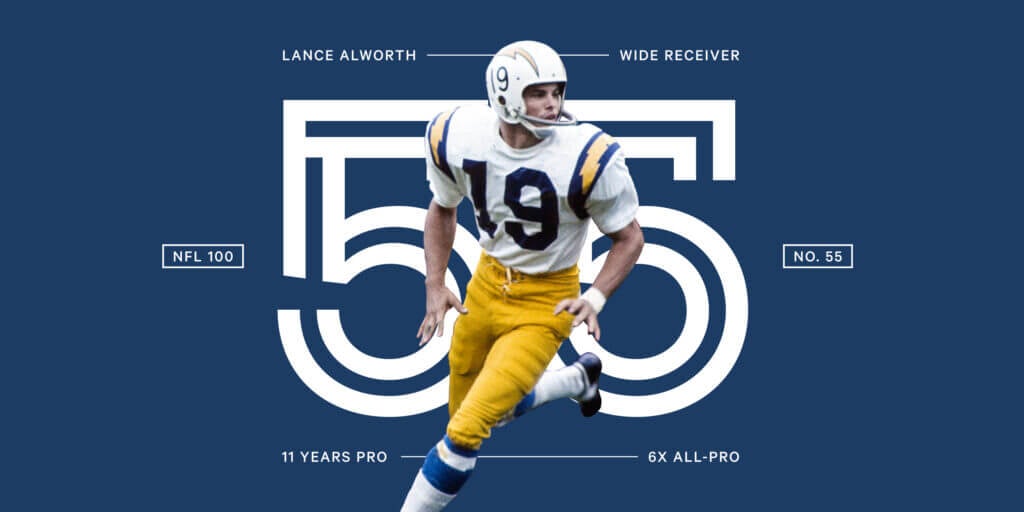
Even when teams didn’t throw the ball as often as they do now, even when defensive backs could get away with more contact at the line of scrimmage, even when teams played only 14 games in a season, Alworth still amassed numbers that stand up nearly 50 years later. “Lance is one of the very few guys that almost universally people say he could still be a star today,” AFL historian and researcher Todd Tobias said. MORE
No. 54: Chuck Bednarik

Bednarik is something of an avatar for a bygone era. As he often reminded anyone who would listen, he was the last of the 60-minute men. In a tough game for tough men, “Concrete Charlie” might have been the toughest of them all. He was a 10-time All-Pro, a first-ballot Hall of Famer and the icon in what might be the most famous football photograph of all time. As longtime general manager Ernie Accorsi succinctly put it, “He was the John Wayne of football.” MORE
No. 53 Gale Sayers

It was quickly evident Sayers was not like the others. In his first preseason game, he returned a punt 77 yards, returned a kickoff 93 yards, and threw a two-yard touchdown pass. During his first season, he broke an NFL record by scoring 22 touchdowns. MORE
No. 52 Jack Ham

If pictures indeed are worth a thousand words, there is no need for dictionaries to describe the position of linebacker in football. They merely could post a photo of Jack Ham. “That,” said Art Rooney Jr., “would be a perfect description.” MORE
No. 51 LaDainian Tomlinson

A gifted athlete with a truly rare combination of speed, strength and vision, he was an utter nightmare in the open field. Corralling him was as difficult as catching a leaf blowing in a swirling gust. His cuts were so quick, so precise, so otherworldly, he would be through a hole and hurdling toward the end zone quite literally in the blink of an eye. And when contact did come, Tomlinson’s 5-foot-10, 215-pound frame was a stone wall — more like a battering ram. MORE
No. 50 Dick ‘Night Train’ Lane

As Packers coach Vince Lombardi told his quarterback, Bart Starr, during Lane’s years with the Lions, “Don’t throw anywhere near him. He’s the best there is.” MORE
No. 49 Steve Young

The path to the pinnacle, which Young reached at the end of the 1994 season by leading the 49ers to a title in Super Bowl XXIX, was anything but a cakewalk. Young has even likened the journey, which featured chapters of distinct challenges, to “climbing Everest.” MORE
No. 48 Sid Luckman

Upon becoming a Bear, Luckman was stunned to open a playbook with 396 plays and thousands of variations. George Halas thought it would take him two years to learn, but Luckman had it down well enough to play in five months. MORE
No. 47 Randy White

“Manster” was an awesome nickname for Randy White that basically meant “half-man, half-monster.” And it fit perfectly because few men terrified opponents as he did. He was one of the scariest men to ever play in the NFL — no small feat for a 265-pound defensive tackle. MORE
No. 46 Tony Gonzalez

Dunking the ball over the crossbar — over and over and over again for most of his 17 seasons — proved to be the perfect image for Gonzalez’s remarkable career, one in which he transformed the tight end position in a way no one else had before him. MORE
No. 45 Larry Allen

To properly express Larry Allen’s legend amongst those who played with him, against him and viewed him from close range, we must enter into evidence that routinely his ability was discussed in terms that made comparisons somewhat pointless. MORE
No. 44 Bruce Matthews

Warren Moon wouldn’t pick anyone but Matthews to block for him on the football field, and Moon also played with Walter Jones, Will Shields, Randall McDaniel and Mike Munchak — Hall of Famers all. MORE
No. 43 Drew Brees

Other quarterbacks won more Super Bowls than Brees. Some were more prolific deep throwers. Others were more dangerous runners and scramblers. But when it came to the simple art of throwing a catchable, accurate, on-time pass, there’s never been anyone better than Brees. MORE
No. 42 Jim Parker

The man who would be described as “an old softy” by his wife after he got teary upon the retirement of his Colts jersey in September of 1968, was a monster on the field to opposing defenders but was jolly and lighthearted off the field. He was the kind of player who understood how to help the team any way he knew how, even if it took him a few years to accept that doing so meant giving up his own wishes about where he might play. MORE
Advertisement
No. 41 O.J. Simpson

Simpson on the record about the arc of his complicated legacy, from football megastar to delightful pitchman/broadcaster/actor to accused double-murderer to dark, pop-culture obsession. MORE
No. 40 Eric Dickerson

Has anybody ever had Dickerson’s almost-regal gait, his ability to get his pads low through the hole and then explode into space running straight up like an Olympic sprinter? He was a long strider, someone who made the difficult look perfunctory. He was the personification of athletic grace. MORE
No. 39 Ed Reed

Locating No. 20, the most dangerous playmaker in the Ravens secondary, was a pre-snap priority. He was the rare defender capable of changing a game with an impact, momentum-turning play. And his infectious swagger and keen instincts emboldened his teammates, inspiring them to another level of execution. MORE
No. 38 Randy Moss

Moss dominated from the moment he stepped on the practice field, reducing the game’s elite to awe while immediately tipping the balance of power from Green Bay to Minnesota in the old NFC Central Division. Defensive backs remain reverent to this day. MORE
No. 37 Jack Lambert

Nearly 30 years after Lambert retired because of a toe injury, he’s still talked about in the same way — one mean SOB whom Steelers fans adore to this day. MORE
No. 36 Forrest Gregg

Forrest Gregg played with Barbie dolls, held teacups with his pinky finger extended and, on most days, would rather knock back a sugary grape soda than a beer. But for 15 or 16 Sundays out of the year, Gregg was an intense destroyer of souls as one of the greatest offensive tackles to ever play in the NFL. MORE
No. 35: J.J. Watt

Watt arrived in Houston with a big work ethic that never really waned. He quickly became the face of the Texans franchise and helped them establish a culture of earning playoff berths, all the while becoming the most dominating defensive player in the NFL. MORE
No. 34: Gino Marchetti
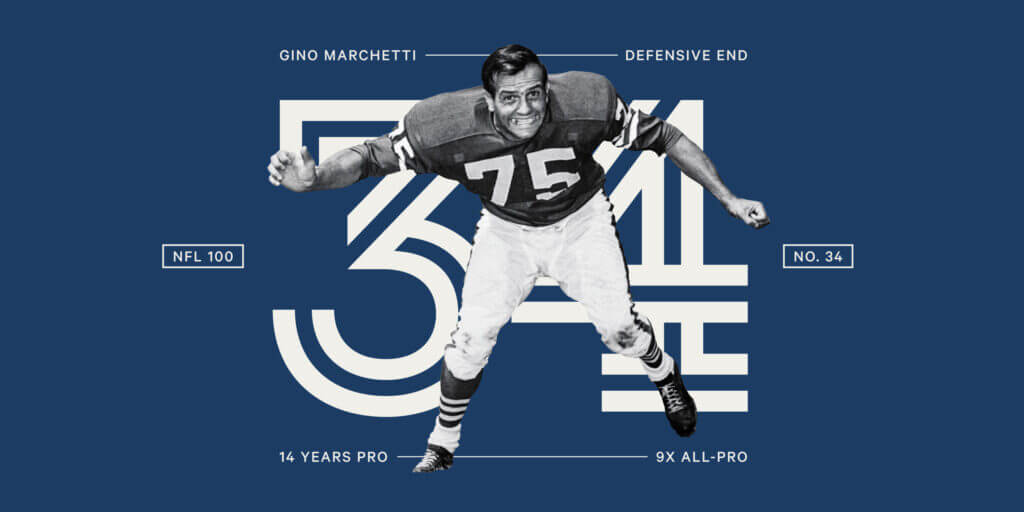
Marchetti was one of the most dominant defensive linemen of all time and — to many — an epitomization of The Greatest Generation. He fought in World War II and made a stand for racial equality more than a decade before the Civil Rights Movement. Colliding with Marchetti, Layne once described, was “like running into a tree trunk in the dark.” MORE
Advertisement
No. 33: Bronko Nagurski

Sid Luckman, once Nagurski’s quarterback on the Bears, said his rival Sammy Baugh told him Nagurski was the most powerful human being he ever encountered. ”How good was he?” Red Grange once said. “On defense, he was equal to Dick Butkus in Butkus’ prime. On offense, he was faster and equal to Larry Csonka. Put the two together and you got Nagurski.” MORE
No. 32: Alan Page

Page was Warren Sapp and Aaron Donald long before the defensive tackles dominated the NFL. No tackle ever produced more sacks than Page. Yet it was his non-football accomplishments he was most proud of. “I find it a bit strange to again be the object of this much attention for what I accomplished many years ago, in a very narrow field of endeavor called football,” Page once said. MORE
No. 31: Bob Lilly

Lilly, the first draft pick in Cowboys history, played 14 seasons in Dallas, missing only one game. He notched 95.5 sacks in 196 regular-season games. He was the face of the original “Doomsday Defense.” Tom Landry once said: “He is something a little more than great. Nobody is better than Bob Lilly.” MORE
No. 30: Merlin Olsen

Many remember Olsen as the five-time All-Pro defensive lineman who anchored one-quarter of the “Fearsome Foursome,” quietly accumulated 14 Pro Bowl berths, sat offensive linemen up out of their socks, held the wall and occupied the space that allowed the swords and arrows to fly all around him and at the poor quarterback on the other side. Others remember him as a “gentle giant.” MORE
No. 29: Emmitt Smith

Smith ran for more yards and touchdowns than anyone in NFL history. The same in the postseason. He won NFL MVP, won Super Bowl MVP and had more consecutive 1,000 yard seasons than anyone. Part of what makes him special: He did it better because he did it for longer than most anybody. MORE
No. 28: Deion Sanders

Sanders remains the only person to score an NFL touchdown and hit an MLB home run in the same week. He’s the only one to play in both a World Series and a Super Bowl. But he was so much more than an accomplished two-sport athlete. No other superstar in NFL history has combined Sanders’ two-sport athletic range with such a deliberately flamboyant public persona. MORE
No. 27: Barry Sanders

Sanders is arguably the greatest running back in NFL history and, without room for debate, one of the most electrifying players of all time. The Hall of Fame back accounted for 18,190 yards from scrimmage and 109 touchdowns before retiring, suddenly, just ahead of the 1999 season. His running style defied logic. The moves he made were incomprehensible. MORE
Advertisement
No. 26: Rod Woodson

Woodson, in a low-key way, made 11 Pro Bowls at three positions and is a six-time All-Pro at two positions. He is a three-time team MVP and was one of only five active players named to the NFL’s 75th anniversary team in 1994. Yet when you hear debates about the best defensive backs who ever played, Deion Sanders is immediately mentioned. Rarely is Rod Woodson. MORE
No. 25: John Hannah

Hannah, former Patriots coach Raymond Berry said, “had everything it takes to be an offensive lineman. Size. Strength. Mentality. He had no weaknesses at all. He was the complete offensive lineman.” The seven-time All-Pro and two-time member of the All-Decade team may have been the best guard in NFL history. MORE
No. 24 Aaron Donald

Los Angeles Rams head coach Sean McVay stood in his office at the top of the team’s hotel tower, just before they opened their 2021 training camp. On a large screen at the front of the room, he turned on a compilation of cut-ups that he feels showcase why three-time Defensive Player of the Year Aaron Donald is the greatest football player currently playing, and certainly belongs within the top 25 of The Athletic’s all-time players. MORE
No. 23 Sammy Baugh

“Slingin’ Sammy” was one of the most accomplished passers of all time. But he also was a safety and punter who performed at a Hall of Fame level at both positions for the Washington Redskins. And he did it all with the flair of a Western hero, which he played in a film series. MORE
No. 22 Brett Favre

The 71,838 yards passing, the 508 touchdowns and, yes, the 336 interceptions matter less to Favre’s football brothers than the teammate whose ability to connect with every one of them off the field, regardless of background, inspired them on it. MORE
No. 21 Aaron Rodgers

It may seem like hyperbole now given everything he has accomplished, but Rodgers has been overlooked the past 20 years more than you’d imagine for a quarterback of his stature. MORE
No. 20 Bruce Smith

“You can look at his sacks, but it’s bigger than that,” seven-time Pro Bowl left tackle Richmond Webb said. “Those pass-rush specialists get to rest on first and sometimes second down and come in fresh. “This guy didn’t leave the field until it was time to punt. He was out there for 10 or 12 plays straight. That’s what is so rare.” MORE
Advertisement
No. 19 Ronnie Lott

The parade of football legends telling him stories, offering him advice and sharing their wisdom never seemed to end. Lott opened his ears and eyes and took everything in. “I met some guys that are part of this top 100 group and I still hear their voices,” Lott said, his own voice crackling with emotion. “I still hear the voices talking to me.” MORE
No. 18 Dan Marino

The statistics, as spectacular as they might have been, couldn’t come close to capturing all of him any more than words could capture a striking sunrise. MORE
No. 17: Ray Lewis

It was the whole experience. For 17 years, Lewis’ pregame dances, passionate speeches and punishing hits defined a football Sunday in Baltimore. Few NFL players are as synonymous with a franchise as Lewis is with the Ravens. MORE
No. 16: Deacon Jones

Some say Jones created the sack by giving it a name. This is disputable. What is indisputable is Jones mastered the sack like no one before him and arguably no one since. Then he turned it into entertainment. MORE
No. 15 John Elway

Elway had unrivaled arm strength and an insane level of competitiveness that carried the Broncos to five AFC championships. He likely would have been a first-ballot Hall of Famer even without a Super Bowl ring. But “The Helicopter” and the Broncos’ upset of the Packers in Super Bowl XXXII catapulted Elway into a different stratosphere. MORE
No. 14: Joe Greene

Greene not only provided the Steelers with perhaps the best defensive tackle ever to play the game, but he also infused them with a passionate distaste for losing on a franchise that had experienced little but that before his arrival. MORE
No. 13: Don Hutson

Hutson was the first modern wide receiver. But he was more than that. He was the first great wide receiver. The case could be made that he was the greatest wide receiver. MORE
No. 12: Anthony Munoz

Munoz is widely regarded as the greatest offensive lineman in NFL history, including by this list. “He wouldn’t just block people. He would totally embarrass them,” said offensive linemate and close friend Dave Lapham. “Finishing wasn’t the word. It was destroying them.” MORE
No. 11: Otto Graham

Graham took the Browns to a championship game in every one of his 10 seasons, and his team won seven of them — the first four in the All-America Football Conference and the last three in the NFL. He lost only 17 games in a decade. His winning percentage of .810 remains the highest in history. It didn’t matter what he was playing, he just won. MORE
Advertisement
No. 10: Dick Butkus

Butkus was fast, strong and smart, but what really made him different was fear. He mastered fear like no one ever, making it work for him and against his opponents. “He terrifies you when he comes charging in like a madman,” Lions running back Mel Farr once said. MORE
No. 9: Johnny Unitas

Unitas was one of the greatest quarterbacks of all time, leading his Baltimore teams to four NFL titles and winning league MVP three times. “If I had my career on the line for one drive after all the football I’ve seen in my life, John Unitas would be the guy I want,” said Ernie Accorsi. MORE
No. 8: Walter Payton
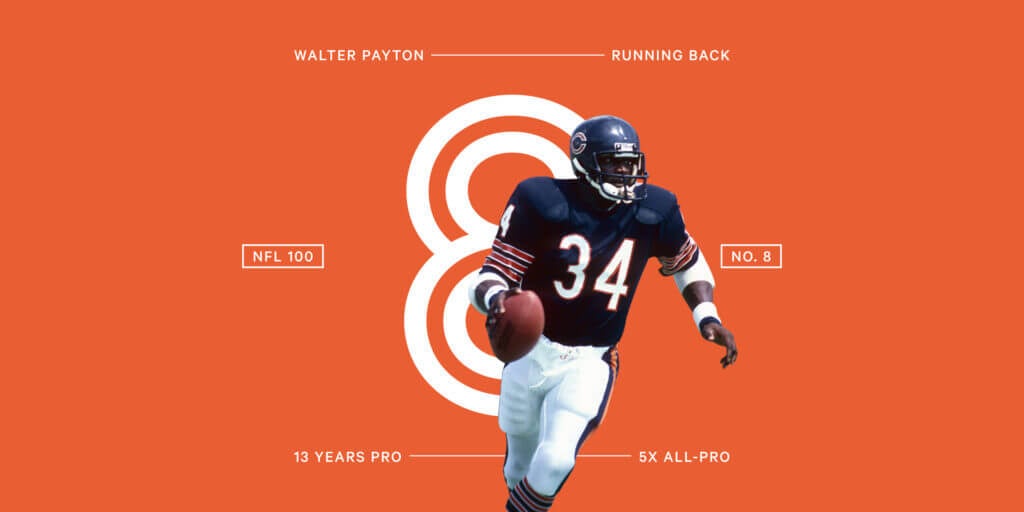
There was nothing the Bears running back couldn’t do and his determination ensured he’d get it done. The essence of the game he played was contact, and no running back ever was better at contact. It wasn’t just run-into-you, run-over-you contact. It was explosive, check-your-teeth contact. MORE
No. 7: Peyton Manning

What separated Manning from his peers was his beautiful mind. Few QBs could process information as quickly and voraciously as Manning. “There are a lot of talented players who don’t work hard and some who do work hard but maybe don’t have the physical ability,” Manning said. “But if you can combine the two and have a passion for the game, well, then you have a chance to be really good.” MORE
No. 6: Joe Montana

Try to pinpoint why the Montana-led 49ers offenses were so successful and you’ll come up with several answers. There was Montana’s brain that could flash through five reads on a single drop back. There was his touch and accuracy, a perfect match for Bill Walsh’s precision offense. There was his icy poise. Then there was Montana’s breezy charm. MORE
No. 5: Reggie White

Over the course of his 15 NFL seasons, White made lasting impressions on everyone he played with, against and for. To his opponents, he was the bare-armed, bare-handed best defensive lineman in the game. To his coaches, he was the skeleton key to great defense. To his teammates, he was a leader, a spiritual advisor and a class clown. MORE
No. 4: Lawrence Taylor

The game-wrecking ability of Taylor, the Giants pass rusher, caused coaches to completely alter their schemes. There was even an acceptance that there was a limit to the effectiveness of any game plan against Taylor. “You just wanted to slow him down a little bit,” Washington’s Joe Theismann said. “At least make him halfway human as opposed to playing Superman.” MORE
Advertisement
No. 3: Jerry Rice

Rice finished his NFL career with more receiving yards, 22,895, and more touchdowns, 208, than anyone in league history. No one was close then, and both records still seem unbreakable now. What stands out most about Rice’s career is the sustained excellence. “There was no limit to the guy,” former coach Paul Hackett said. MORE
No. 2: Jim Brown

Brown averaged 104.3 rushing yards per game in his career — still the most in league history by nearly five yards. He did it in an era when defenders could get away with doing almost anything they wanted to ball carriers — and usually did. He dominated even though he was the focal point of every defensive game plan in every game of his career. MORE
No. 1: Tom Brady

Brady’s seventh NFL title in February gave him more Super Bowl victories than any franchise, and there’s no mystery to his success. The drive for each Lombardi Trophy has consumed every moment of his life. “He’s not the biggest, fastest, all that stuff, but he’s the winner of all winners,” Bucs coach Bruce Arians said. MORE
(Photos: Getty Images and Associated Press; Illustration: The Athletic Design Team)
